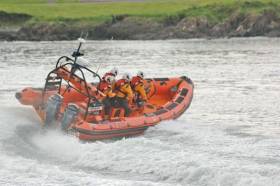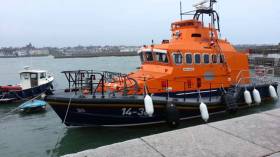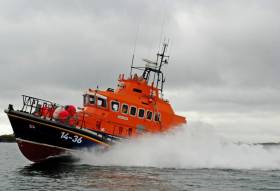Displaying items by tag: Donaghadee
Manx & NI Lifeboats Assist Broken Down Angling Vessel
#RNLI - Ramsey RNLI on the Isle of Man launched its all-weather lifeboat Ann & James Ritchie yesterday afternoon (Wednesday 23 May) to render assistance to a day angling vessel with three people on board.
The 21ft vessel had broken down seven miles south-west of Burrow Head in the Irish Sea. In fair weather conditions and a slight sea, the Ramsey lifeboat with acting coxswain Ali Clague at the helm located the stricken vessel at 1.20pm, 70 minutes after launch.
A tow was safely established, and it was advised by Belfast Coastguard that the lifeboat should bring the vessel towards Donaghadee on the Ards Peninsula.
Donaghadee’s all-weather lifeboat Saxon was tasked to rendezvous with the Ramsey crew and the two lifeboats met approximately one mile to the west of Mull of Galloway lighthouse at 3.25pm where the tow was passed.
#Missing - RNLI lifeboats from Bangor and Donaghadee have joined the search for a speedboat with two men missing off the Scottish coast, as BBC News reports.
Coastguard volunteers from Bangor are also part of the emergency operation launched last night (Saturday 6 May) when the two men failed to return to Port Logan in Dumfries and Galloway.
Searches for the missing vessel, thought to be an 18ft black Fletcher speedboat, are concentrated off the Mull of Galloway for the time being.
BBC News has more on the story HERE.
Donaghadee Kayaker Callout Was ‘Elaborate Hoax’
#Hoax - The UK coastguard has decried an “elaborate hoax” after lifeboats and a coastguard helicopter were launched after several calls from someone claiming to be a kayaker in difficulty off the Co Down coast.
As BBC News reports, lifeboats from Bangor and Donaghadee RNLI respectively joined a rescue helicopter from HM Coastguard in Scotland in the search off the Copeland Islands yesterday (Sunday 2 April) that was declared a hoax after a thorough search of the area.
Three Callouts To Help Vessels In Difficulty For Donaghadee Lifeboat
#RNLI - Donaghadee RNLI was called upon three times in the last week to assist vessels which got into difficulties off the coast of North Down.
The first callout was on Thursday 25 August after a yacht with five people aboard struck rocks at the South Briggs buoy in the Copeland Sound.
At the scene, the crew of the all-weather lifeboat Saxon established that no one was injured and the yacht was still seaworthy.
The volunteers and the lifeboat escorted the vessel to a safe harbour for full inspection of the damage to the hull. Conditions were calm.
Saturday 27 August also saw a fine and calm summer’s evening when a RIB with five aboard set off from Scotland for Bangor, but encountered engine failure in the middle of the North Channel as night began to fall.
An emergency call was made to Belfast Coastguard and the lifeboat was requested to respond. The drifting RIB was quickly located eight miles from the Scottish coast. A tow-line was secured and the helpless boat and passengers were in Bangor before last light.
Saxon and crew were called out again on Bank Holiday Monday yesterday to come to the rescue of a small fishing boat with one person aboard.
The eight-metre vessel suffered engine failure and began dragging its anchor in choppy conditions near rocks at Burial Island off Ballyhalbert.
The boat was towed to Portavogie for repairs by another vessel and the lifeboat escorted the pair safely to harbour.
Three Calls In 24 Hours For Donaghadee Lifeboat Volunteers
#RNLI - Donaghadee’s RNLI lifeboat Saxon put to sea three times in 24 hours during a busy weekend keeping aircraft passengers and pleasure sailors safe around the North Down coast.
The first call came at 5.30pm on Friday (19 August) when an inbound aircraft heading for George Best Airport reported technical problems and HM Coastguard requested a launch in keeping with established air emergency procedures. These ensure a swift response from lifeboats should an aircraft be forced to ditch at sea.
The Donaghadee lifeboat made its way at top speed of 25 knots to a designated location along the flight path. However, the aircraft was able to land without incident and the lifeboat returned to station. The operation also involved Bangor and Larne RNLI crews.
On Saturday morning (20 August), the Donaghadee crew launched around 11am after a report that a 20ft yacht had run aground on rocks at Craigbrain, near Ballyferris caravan park.
At the scene, the crew launched the smaller inflatable lifeboat in difficult conditions with a 1.5m swell, but established that no one was aboard the grounded catamaran.
Safety advice was given from coastguard officers on the shore and it was decided to let the incoming tide lift the yacht off the rocks to allow for a safer retrieval by the owner.
The crew had just returned to the boathouse at 12.30pm when the coastguard requested another launch. This time a 31ft yacht, with three people aboard, had reported an engine fire east off Burr Point near Ballyhalbert.
On the way, the lifeboat crew encountered treacherous seas with 5m waves, making for an uncomfortable passage.
Once on scene, the crew of the yacht confirmed they heard automatic fire extinguishers firing in the engine room. The lifeboat approached, secured a towline and set course for the difficult passage back to Donaghadee.
The stricken yacht was brought alongside and berthed in the harbour, where two appliances from the Northern Ireland Fire and Rescue Services attended as a precaution.
The lifeboat and her crew were back at sea on Sunday morning to conduct a regular training exercise.
Donaghadee RNLI deputy coxswain John Ashwood said: ”It has been a quiet summer for the crew so far but this weekend was one of the busiest 24-hour periods we have experienced in quite some time. We are always ready to respond if lives are in danger at sea.”
Donaghadee RNLI Rescues Stricken Yacht As Darkness Falls
#RNLI - Donaghadee RNLI's lifeboat crew saved a stricken yacht with one person onboard after it was left helpless in poor weather off the coast of Millisle, Co Down.
Donaghadee lifeboat Saxon and her volunteer crew sped to the last reported position of the vessel at top speed of 25 knots after a launch request from the coastguard at 9.30pm on Friday evening (15 July).
A strong south-westerly wind was blowing with rain forecast, and night was falling as the lifeboat crew searched before locating the yacht two miles offshore. No radio contact was possible.
A towline was quickly attached and the yacht brought to Donaghadee Harbour for inspection and repairs.
It was the lifeboat’s second launch of the week. Last Sunday evening (10 July) Saxon and crew put to sea in response to a man overboard alert in Ballyhalbert after a pleasure sailor fell from his boat and was unable to get back aboard.
However, the casualty was assisted by another vessel and was able to make his way ashore uninjured.
Donaghadee RNLI coxswain Philip McNamara said: "We are always happy to launch if there is a chance we can prevent an emergency or save a life at sea. But everyone enjoying the coast this summer should respect the water and wear lifejackets when around deep water.
"If you are boating make sure you have a reliable means of contacting the shore and of calling for help."
Donaghadee Lifeboat Volunteers Are Ready For Action
#RNLI - On Sunday 6 March 2016, Donaghadee RNLI coxswain Philip McNamara and the volunteer lifeboat crew mustered for the latest in a series of vital fortnightly sea training exercises to ensure they are prepared for the challenges of the year ahead.
The Trent Class lifeboat Saxon was also hauled up a slipway in Carrickfergus last week to have its hull power-washed and a fresh coat of antifouling paint applied. The task is undertaken every six months to ensure the £2 million vessel is always at peak performance and can reach the scene of an emergency at 25 knots.
Last year Donaghadee’s RNLI volunteers responded to 23 calls for help starting in January when they battled "atrocious" seas to bring an injured workman from the Copeland Islands where he has working on the lighthouse.
The lifeboat crew rescued stranded kayakers and their dogs. They came to the rescue of a member of the crew on a cross channel ferry who had taken seriously ill during a night crossing.
“It has been a relatively quiet winter for us but the number of rescue requests usually picks up around Easter and reaches a peak in summer," said McNamara.
"The crew is ready and the lifeboat is ready too. Every time we put to sea volunteers risk their lives to save others but we are trained and experienced, to deal with emergencies and are part of a dedicated team which includes the Coastguard, Police Service of Northern Ireland, Northern Ireland Fire and Rescue Service and Air Sea Rescue.”
The Donaghadee crew is at full strength, but lifeboat operations manager Peter Irwin says there is still room for more.
“We would like two more trainees to join us and I would be happy to hear from suitable people in the town who feel they can give their time to the charity that saves lives at sea.”
#RNLI - Christmas came early at Donaghadee Primary School yesterday (Tuesday 24 November) as children enjoyed a reading of an RNLI festive story.
Accompanied by Rookie the RNLI Reindeer and coxswain Philip McNamara, Donaghadee RNLI’s deputy second coxswain John Ashwood read The Big Christmas Rescue to a group of pupils in Primary One.
The kids were able to hear about the station’s all-weather lifeboat and learned about the lifesaving service that the RNLI provides.
The story is set on a wet and windy Christmas Eve night. But when Santa crashes his sleigh in the sea, volunteer RNLI lifeboat crew members go to the rescue.
The Big Christmas Rescue children’s book is also customisable, making it a perfect seasonal gift.
It can be personalised to put young readers at the centre of a magical festive story, and the gift-giver can select the name, gender and skin tone of the child in the story, making it a truly unique present for their own special little person.
"I really enjoyed reading the story to the children," said Ashwood. "They all seemed to enjoy the book and it was great to tell the children about the lifesaving service we provide at the RNLI.
"The Big Christmas Rescue is a really beautiful book and it’s the perfect gift for children this Christmas. I love the way the book can be personalised, putting readers at the heart of the story. Importantly, all profits from sales of the book will help the RNLI continue to save lives at sea."
To order a personalised copy of The Big Christmas Rescue, go to RNLISHOP.org/BigRescue. The last order date for the book to guarantee delivery before Christmas is Sunday 13 December 2015.
All profits from book sales will be used to fund the charity’s lifesaving services, delivered by volunteer lifeboat crews and lifeguards who between them rescued 10,496 people last year – more than 1,400 across the island of Ireland alone.
Bangor, Larne & Donaghadee Lifeboats Launch To Air Emergency
#RNLI - Lifeboats from Bangor, Donaghadee and Larne were launched last night (Tuesday 27 October) as part of a major operation after a flight out of Belfast declared an emergency.
Police, fire and ambulance crews were also involved in the cross-agency response to the British Airways flight from Belfast City Airport to Heathrow, with 108 passengers aboard, which diverted to Belfast International Airport shortly after take-off as the pilot declared an emergency.
The RNLI lifeboats were on the water within 10 minutes of receiving a request from HM Coastguard and proceeded to positions which are part of a practiced air emergency plan.
Thankfully the services of the volunteer crews were not required and the lifeboats returned to station within the hour.
Alan Whiteside, operations director at Belfast International Airport, said: "Everything went smoothly, our own police and fire service on site here responded, the Northern Ireland Fire and Rescue Service, the PSNI, the Northern Ireland Ambulance Service all attended as a routine.
"But nobody was required to take any other action - the aircraft landed safely, thankfully."
Donaghadee Lifeboat In Search For Stranded Dog
#RNLI - RNLI volunteers aboard Donaghadee’s all-weather lifeboat Saxon launched on Tuesday night (29 September) to search for a family’s pet dog which was reported to have been cut off by the tide at Millisle on the Ards Peninsula.
Coxswain Philip McNamara and his crew took the decision to launch after a request from Belfast Coastguard at 9.30pm and were on the water within 10 minutes.
When they reached the area, the crew launched a smaller inflatable craft, designed for inshore work, and conducted a search of the shoreline in darkness.
"We could find no trace of the dog and hope that it reached safety," said McNamara. "There is always the possibility that someone will enter the water to save a family pet and that means there is a risk of them drowning. The RNLI is here to save lives at sea no matter what the circumstances might be."
The launch came just a day after the Donaghadee crew spent eight hours afloat as part of a major search operation for a missing kayaker, as previously reported on Afloat.ie.
Elsewhere, Skerries RNLI towed a fishing boat with four men on board to safety on Sunday (27 September) after a passing yacht alerted the lifeboat that the vessel was in difficulty.
While out on routine Sunday morning training some two miles northeast of Skerries, helm Eoin Grimes and crew members Peter Kennedy and AJ Hughes were called into action after learning from the skipper of a passing yacht that a fishing boat nearby had suffered engine failure.
The fishing vessel, which had four men on board, was taken under tow by the lifeboat and towed to the safety of Balbriggan Harbour, where they had set out from. Conditions at the time were calm with a Force 1 to 2 southerly wind.
Speaking after the callout, Skerries RNLI volunteer lifeboat press officer Gerry Canning said: "We would urge anyone going to sea to ensure that have adequate safety equipment on board and a means of contacting the shore should they experience any difficulty."



































































